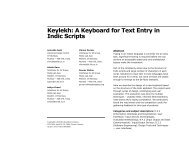Sphinx Guideline version 1
Sphinx Guideline version 1
Sphinx Guideline version 1
Create successful ePaper yourself
Turn your PDF publications into a flip-book with our unique Google optimized e-Paper software.
3.4 Decoding With <strong>Sphinx</strong><br />
As mentioned above, you need the following files for decoding:<br />
Trained models<br />
Dictionary<br />
Filler dictionary<br />
Language model/ FSG<br />
Test data<br />
To get a list of arguments in <strong>Sphinx</strong>3 decode, just type sphinx3_decode in the command line. You<br />
will get a list of arguments and their usage.<br />
In general, the configuration file needs, at the very least, to contain the following arguments:<br />
-hmm followed by the acoustic model directory<br />
-dict followed by the pronunciation dictionary file<br />
-fdict followed by filler dictionary<br />
-lm followed by the language model, OR<br />
-fsg followed by the grammar file<br />
-ctl followed by the control file (fileids)<br />
-mode fsg (for FSG, for n-gram let it be the default mode, so need to specify this for n-gram)<br />
However, in this case, there are several additional arguments that are necessary:<br />
-adcin yes (tells the recognizer that input is audio, not feature files)<br />
-adchdr 44 (tells the recognizer to skip the 44-byte RIFF header)<br />
-cepext .wav (tells the recognizer input files have the .wav extension)<br />
-cepdir wav (tells the recognizer input files are in the 'wav' directory)<br />
-hyp followed by the output transcription file<br />
In case your training arguments are different from default arguments, then set it manually by<br />
providing the following parameters.<br />
-hypseg \ (followed by Recognition result file, with word segmentations and scores)<br />
-logfn \ (followed by Log file (default stdout/stderr))<br />
-verbose yes \ (Show input filenames)<br />
-lowerf 133.33334 \ (Lower edge of filters)<br />
-upperf 3500 \ (upper edge of filters)<br />
-nfft 256 \ (Size of FFT)<br />
-wlen 0.0256 \ (Hamming window length)<br />
-nfilt 33 \ (Number of filter banks)<br />
-ncep 13 \ (Number of cep coefficients)<br />
-samprate 8000 \ (Sampling rate)<br />
-dither yes (Add 1/2-bit noise)<br />
The parameters like lowerf, upperf, nfft, wlen, nfilt,ncep should be same as used for training for<br />
good results.<br />
23



